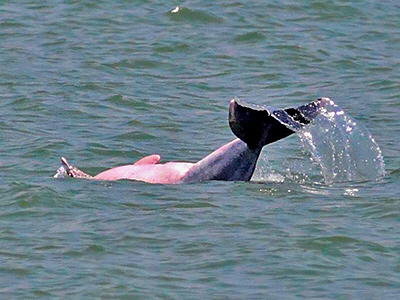 |
Order : CETARTIODACTYLA
Infraorder : Cetacea
Family : Delphinidae
Species : Sousa
chinensis
Total Length :
Typically up to 2.8 metres, but sometimes larger.
Weight : up to 230 kg
Sousa chinensis occurs in warmer, sheltered waters of the eastern Indian and
western Pacific oceans, as well as coastal waters in the South China Sea.
Small groups may also venture into mangrove and estuarine habitats.
Indo-Pacific Humpback dolphins have a streamlined head and body, and a
long, slender beak. Their colour may vary from whitish or pale grey to
medium grey (sometimes speckled) to pink (particularly in older dolphins).
There is typically, but not always, a low hump on the back, immediately
beneath the small, triangular dorsal fin.
Their food prey comprises mainly fish, which can be caught through deep
dives or by rapid chases in shallow waters. Group size is typically less
than 10.
Jefferson & Smith (2015) list the range countries as follows: Brunei,
Cambodia, Indonesia (Sumatra, Java, Borneo), Malaysia, China, Singapore,
Taiwan, Thailand and Vietnam (records from other countries are considered as unconfirmed or extralimital).
In some locations, numbers of this species are in decline due to coastal
pollution, including the ingestion of plastic waste.
Fig 1 : Example from shallow, coastal waters off the north of the island of
Pulau Pinang, Peninsular Malaysia. This is an adult, with a markedly pink
belly. Photo thanks to Graeme Guy
Figs 2 to 4 : Recently deceased example which washed ashore on the east
coast of Johor, Peninsular Malaysia at Air Papan beach,
which faces the South China Sea, on 03 June 2014. This dolphin was identified as Sousa chinensis
based on its size, estimated as 2.0 metres, the triangular shape of its
dorsal fin and its relatively long, slender beak.
References :
Francis, C.M. 2019. A Field Guide to the Mammals of South-east Asia. Second
Edition. New Holland. 416 pp.
Jefferson, T. A. & Smith, B. D. (2015). Re-assessment of the conservation
status of the Indo-Pacific humpback dolphin (Sousa chinensis) using
the IUCN Red List Criteria. Advances in Marine Biology : Humpback Dolphins
(Sousa spp.) : Current Status and Conservation, Part 2. 73: 1-21
|